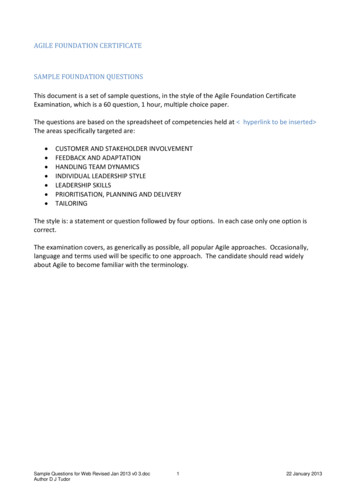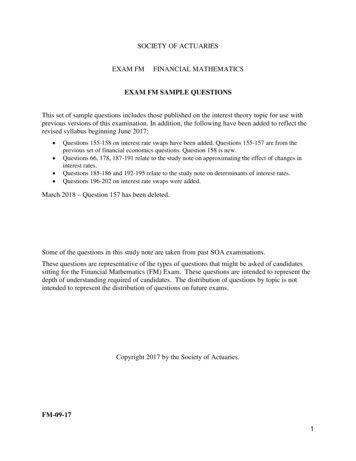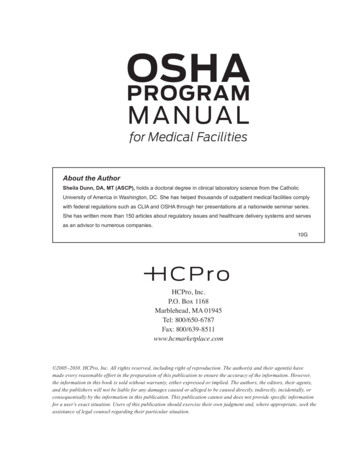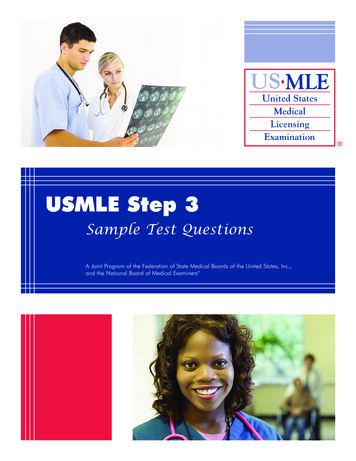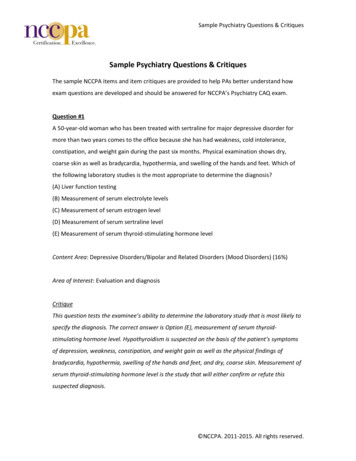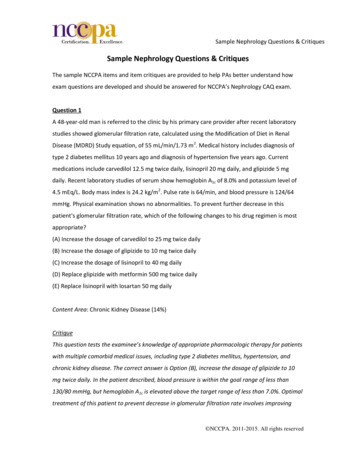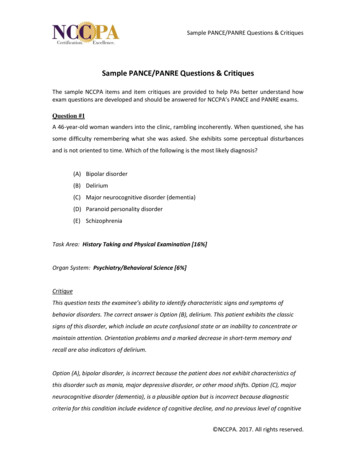
Transcription
Sample PANCE/PANRE Questions & CritiquesSample PANCE/PANRE Questions & CritiquesThe sample NCCPA items and item critiques are provided to help PAs better understand howexam questions are developed and should be answered for NCCPA’s PANCE and PANRE exams.Question #1A 46-year-old woman wanders into the clinic, rambling incoherently. When questioned, she hassome difficulty remembering what she was asked. She exhibits some perceptual disturbancesand is not oriented to time. Which of the following is the most likely diagnosis?(A) Bipolar disorder(B) Delirium(C) Major neurocognitive disorder (dementia)(D) Paranoid personality disorder(E) SchizophreniaTask Area: History Taking and Physical Examination [16%]Organ System: Psychiatry/Behavioral Science [6%]CritiqueThis question tests the examinee’s ability to identify characteristic signs and symptoms ofbehavior disorders. The correct answer is Option (B), delirium. This patient exhibits the classicsigns of this disorder, which include an acute confusional state or an inability to concentrate ormaintain attention. Orientation problems and a marked decrease in short-term memory andrecall are also indicators of delirium.Option (A), bipolar disorder, is incorrect because the patient does not exhibit characteristics ofthis disorder such as mania, major depressive disorder, or other mood shifts. Option (C), majorneurocognitive disorder (dementia), is a plausible option but is incorrect because diagnosticcriteria for this condition include evidence of cognitive decline, and no previous level of cognitive NCCPA. 2017. All rights reserved.
Sample PANCE/PANRE Questions & Critiquesperformance is known for the patient described. In addition, although major neurocognitivedisorder (dementia) can develop in middle age, it is primarily seen in elderly individuals. Also, thepatient has some features of dementia but does not have common features such as agitation orwithdrawal, hallucinations, or a loss of inhibitions. Option (D), paranoid personality disorder, isincorrect because the patient does not exhibit the signs of this disorder, which may includedefensive, suspicious, secretive, or oversensitive behavior. Although the patient has somesymptoms of Option (E), schizophrenia, she does not have core psychotic features such asdelusions, hallucinations, disorders of language, or inappropriate affect. Therefore, Option (E) isincorrect.Question #2Six days ago, a 2-year-old boy had a temperature of 40.0 C (104.0 F). No specific cause wasfound. His fever has persisted, and he now has injected conjunctivae, strawberry tongue, dryfissured lips, erythema and desquamation of his hands and feet, and bilateral cervicaladenopathy. Which of the following is the most likely complication of this condition?(A) Chorea(B) Heart failure(C) Coronary artery aneurysm(D) Mesenteric arteritis(E) Valvular heart diseaseTask Area: Formulating Most Likely Diagnosis [18%]Organ System: Infectious Disease [3%]CritiqueThis question requires the examinee to first identify the disorder, Kawasaki syndrome, and thendetermine the most likely complication associated with this disorder. The correct answer isOption (C), coronary artery aneurysm. The clinical scenario described includes the characteristicpresentation of Kawasaki syndrome: fever, age younger than 5 years, conjunctivitis, mucous NCCPA. 2017. All rights reserved.
Sample PANCE/PANRE Questions & Critiquesmembrane abnormalities, peripheral extremity abnormalities, polymorphous rash, and cervicallymphadenopathy. Coronary artery aneurysm is the most common complication of Kawasakisyndrome, occurring in about 25% of untreated patients.Option (A), chorea, is incorrect because the patient does not present with dyskinesia, acharacteristic of chorea. Option (B), heart failure, is incorrect. While many infectious agents mayprogress to myocarditis and heart failure, coronary artery aneurysm is a specific sequela and themost common complication of Kawasaki syndrome. Option (D), mesenteric arteritis, is alsoincorrect because arteritis from Kawasaki syndrome favors the coronary circulation. Option (E),valvular heart disease, is incorrect because this patient does not have characteristics of thisdisease, which include evidence of past infection with group A beta-hemolytic streptococcusresulting in rheumatic heart disease.Question #3A 31-year-old African American woman has had worsening malaise, dyspnea, and low-gradefever for the past four weeks. She was recently treated for iritis. On physical examination, rednodules over the anterior lower legs and mild hepatomegaly are noted. Chest x-ray study showsbilateral hilar adenopathy. Which of the following is the most likely diagnosis?(A) Lymphoma(B) Mesothelioma(C) Sarcoidosis(D) Tuberculosis(E) Wegener granulomatosisTask Area: Formulating Most Likely Diagnosis [18%]Organ System: Pulmonary [12%] NCCPA. 2017. All rights reserved.
Sample PANCE/PANRE Questions & CritiquesCritiqueThis question tests the examinee’s knowledge of common signs and symptoms of diseases. Thecorrect answer is Option (C), sarcoidosis. The age, gender, and race of the patient, in addition tothe insidious onset of symptoms and x-ray study findings, are all characteristics of this disease.Option (A), lymphoma, is a plausible option, because lymphoma and sarcoidosis share similarsymptoms such as insidious onset, fever, malaise, dyspnea, visceral involvement, and a widenedmediastinum. However, the history of iritis and presence of erythema nodosum in a youngAfrican American woman are more characteristic of sarcoidosis than lymphoma. Option (B),mesothelioma, is incorrect because the mean age of onset of this disease is approximately 60years. Mesothelioma is also commonly found among workers exposed to asbestos. Option (D),tuberculosis, is incorrect because this patient does not have the classic characteristics of thisdisease, which include weight loss, night sweats, chronic productive cough, or apical lesionsshown on chest x-ray study. Option (E), Wegener granulomatosis, is incorrect because thepatient is not in her 40s or 50s, she did not have a prolonged onset of symptoms, and there areno upper and lower respiratory tract symptoms, including necrotizing granulomatous lesions,glomerulonephritis, and vasculitis. Also, the finding on x-ray study of hilar adenopathy is notconsistent with Wegener granulomatosis.Question #4For the past three weeks, a 47-year-old man has had the feeling of heaviness in his chest whilepushing his lawn mower. He says he has never been treated for similar symptoms and has nosymptoms now. He smoked one pack of cigarettes daily for 20 years but quit smoking sevenyears ago. Findings on physical examination are normal. Electrocardiography shows noabnormalities. Which of the following is the most appropriate initial diagnostic study?(A)Coronary arteriography(B)Echocardiography(C)Exercise stress test(D)24-Hour ambulatory cardiac monitoring(E)Myocardial perfusion scan NCCPA. 2017. All rights reserved.
Sample PANCE/PANRE Questions & CritiquesTask Area: Using Laboratory and Diagnostic Studies [14%]Organ System: Cardiovascular [16%]CritiqueThis question tests the examinee’s ability to identify the most appropriate initial diagnostic studyin a patient with possible coronary artery disease. Option (C), exercise stress test, is correctbecause it is the most appropriate initial step in the workup of a patient with recent chest painbecause the test is noninvasive, inexpensive, convenient, and sensitive in this type of patient.The most definitive diagnostic test for a patient with coronary artery disease is Option (A),coronary arteriography, but this test is not the most appropriate initial test in an asymptomaticpatient with no abnormal findings on electrocardiography. Option (B), echocardiography, is avaluable tool for examining valvular structures, cardiac size, ejection fraction, as well as otheranatomic features. However, echocardiography is not routinely indicated for evaluating ischemiaresulting from coronary artery disease and is, therefore, incorrect. Option (D), 24-hourambulatory cardiac monitoring, is also incorrect. Twenty-four-hour ambulatory cardiacmonitoring is used primarily for evaluating disturbances of rate and rhythm and it is able todetect ST-segment depression, but it is less effective than exercise stress testing in confirming adiagnosis of coronary artery disease in the initial workup of a patient. This patient’selectrocardiogram shows no abnormalities, and therefore, Option (E), myocardial perfusion scan,is incorrect. This option would only be correct if the results of resting electrocardiography wereabnormal, making it difficult to interpret an exercise stress test.Question #5A 32-year-old woman has had a rash on her legs for the past three weeks. There are no knowninfectious contacts. One month ago, she had a bladder infection and was treated withtrimethoprim-sulfamethoxazole. Physical examination shows a diffuse rash on the shins, the leftmedial ankle, and the right medial calf. The rash is tender, diffuse, and recurs in the same areas.A few of the lesions have the appearance of bruising. Which of the following is the most likelydiagnosis? NCCPA. 2017. All rights reserved.
Sample PANCE/PANRE Questions & Critiques(A) Erythema multiforme(B) Erythema nodosum(C) Lichen planus(D) Lichen simplex(E) Nummular eczemaTask Area: History Taking and Physical Examination [16%]Organ System: Dermatology [5%]CritiqueThis question tests the examinee’s ability to diagnose a rash based on the patient’s history andthe description of the rash. The examinee must first consider that the rash could be an allergicreaction to the sulfa antibiotic. The correct answer is Option (B), erythema nodosum, becausethis type of rash may be antibiotic-related, occurs on the lower extremities below the knees, andhas the appearance of bruising. All of these symptoms are present in this clinical scenario.Options (A), erythema multiforme, and (C), lichen planus, can also result from an allergicreaction to a sulfa antibiotic, but the presentation of this patient’s rash is not consistent witheither of these conditions. Options (D), lichen simplex, and (E), nummular eczema, are chronicconditions that result in scaling. Therefore, given the time frame and the presentation of thispatient’s rash, these two options are incorrect.Question #6A 33-year-old woman at 35 weeks' gestation has constant pelvic pain. She says that she had asmall amount of dark red vaginal bleeding after sexual intercourse. Her blood pressure is 80/50mmHg, and she has tachycardia. The uterus is firm and tender to palpation. Which of thefollowing is the most likely diagnosis?(A) Abruptio placentae(B) Cervical laceration NCCPA. 2017. All rights reserved.
Sample PANCE/PANRE Questions & Critiques(C) Placenta previa(D) Preterm labor(E) Vasa previaTask Area: History Taking and Physical Examination [16%]Organ System: Reproductive [8%]CritiqueThis question tests the examinee’s ability to determine an emergent situation by recognizingtachycardia and significant hypotension as abnormal in a patient at this stage of pregnancy.Option (A), abruptio placentae, is the correct answer, because in addition to the tachycardia andsevere hypotension, this patient has also had a small amount of dark red vaginal bleeding.Option (C), placenta previa, is plausible but incorrect. This patient’s vaginal bleeding is notsignificant nor is it bright red, which are characteristic of placenta previa. Option (B), cervicallaceration, is incorrect because this patient is in the antepartum stage of pregnancy, and cervicallaceration typically results from passage of the fetus through the birth canal. Option (D), pretermlabor, is incorrect because there is no history of this patient having any uterine contractions, anobvious sign of preterm labor. Option (E), vasa previa, is incorrect. This is a condition wherebythe umbilical vessels overlay the internal cervical os and may be a cause of third-trimesterbleeding. However, this patient does not have copious vaginal bleeding of bright red blood.Question #7A 41-year-old woman has a nine-month history of nausea, constipation, dyspepsia, generalfatigue, arthralgia, and increasing memory loss. She has no history of illness other than herpresent complaints, and her menses have been regular. Physical examination shows noabnormalities. Laboratory findings include the following levels: NCCPA. 2017. All rights reserved.
Sample PANCE/PANRE Questions & CritiquesSerumAlbumin4.9 g/dLCalcium13.0 mg/dLChloride111 mEq/LCreatinine1.0 mg/dLPhosphate0.3 mg/dLBlood urea nitrogen17 mg/dLWhich of the following is the most likely diagnosis?(A) Cushing syndrome(B) Hyperparathyroidism(C) Hypopituitarism(D) Malabsorption(E) Multiple myelomaTask Area: Formulating Most Likely Diagnosis [18%]Organ System: Endocrine [6%]CritiqueThis question tests the examinee’s ability to review a detailed clinical scenario, includinglaboratory values, to establish the cause of the patient’s condition. Option (B),hyperparathyroidism, is the correct answer. The patient has the classic signs of this condition,which include gastrointestinal, musculoskeletal, and neurologic abnormalities. Additionally, thelaboratory values clearly show hypercalcemia and hypophosphatemia, both of which indicatehyperparathyroidism.Option (A), Cushing syndrome, is incorrect because the patient does not have the typicalsymptoms of Cushing syndrome, which include oligomenorrhea or amenorrhea and a host ofchanges to the body habitus. Option (C), hypopituitarism, is incorrect because the patient does NCCPA. 2017. All rights reserved.
Sample PANCE/PANRE Questions & Critiquesnot have severe metabolic, growth, and menstrual abnormalities as a result of a decrease inpituitary hormone levels. Option (D), malabsorption, is incorrect because there is no indication inthe patient’s history of weight loss, other illness, or abnormal menses. In addition, the
This question tests the examinee’s ability to diagnose a rash based on the patient’s history and the description of the rash. The examinee must first consider that the rash could be an allergic reaction to the sulfa antibiotic. The correct answer is Option (B), erythema nodosum, because this type of rash may be antibiotic-related, occurs on the lower extremities below the knees, and has .


